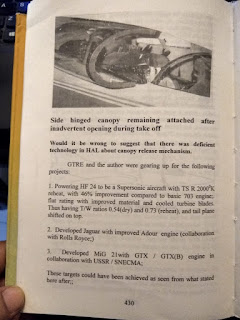HF-24 'Marut' was independent India's first attempt at creating a supersonic fighter aircraft and ushering self reliance in the critical field of fighter aircraft aviation. The country did invest considerable resources into the project and went to the extent of inviting the acclaimed German airplane designer of World War-2 fame, Professor Kurt Tank to design such a fighter aircraft. He had designed iconic fighter like the Fw 190, the back-bone of German Air Force or Luftwaffe for most of World War 2.
In spite of considerable effort, HF-24 Marut could not meet the Air Staff Requirement (ASR) parameters. And the biggest reason for that was lack of suitable engines. Professor Kurt Tank had designed the aircraft around an engine being developed by Bristol Siddeley of UK. However, Bristol Siddeley never managed to develop the engine due to some decisions made in that nation and Bristol Siddeley lost the economic reason to pursue further development. However, Bristol Siddeley did approach Indian government to fund the development. The story goes that they were asking for a very steep price and Indian government refused to fund the same.
In hindsight, that proved to be much more costly decision than whatever money they were asking. Reason being, HF-24 'Marut' never reached its optimal performance and instead, was flown with Bristol Siddeley B.Or. 703 engines, the same ones on Folland Gnat.
Still, 140+ Marut were manufactured and all of them served with three operational squadrons of the IAF. Tragedy was that an aircraft meant as high altitude, high speed interceptor, was employed in ground attack role!
And in less than two decades, HF-24 'Marut' was phased out of IAF, never having achieved its potential.
Popular perception says that it was lack of interest by IAF which led to the early demise of the fighter. That it did not support the program enough. Reality speaks otherwise.
However, there is one more angle to the story - and that is the role of Professor Kurt Tank and design team at HAL in scuttling a reheat or after-burning project at GTRE. A project, if it would've reached its logical conclusion, would've made HF-24 much more powerful aircraft. And allowed it to meet a high percentage of its expected requirement.
Further, there is more to HF-24 design and role of Professor Kurt Tank. However, I shall touch upon that later.
As for now, I produce excerpts from autobiography of Air Vice Marshal SN Roy Chowdhury. These excerpts tell you about the little know efforts made by GTRE to power HF-24 with a reheat engine and how, the obstinacy of Professor Kurt Tank and Indian members of design team at HAL, prevented this venture from reaching its logical conclusion.
Before I proceed, I'm attaching pics of tail pipes of HF-24 MK1 and HF-24 Mk1R (this prototype flew with reheat engines). The excerpts linked below refer to this aspect of design repeatedly and are central to understand the issue which prevented evolution of HF-24 Mk1R into a true-blue after-burning fighter aircraft.
Tail section - HF-24 Mk1
Tail section - HF-24 Mk1R
The above aircraft, BD-884, is the first prototype to fly with reheat engines and underwent trials from 1966-1970.
Excerpts
There is more to this story. I'll add more sections later.
























No comments:
Post a Comment